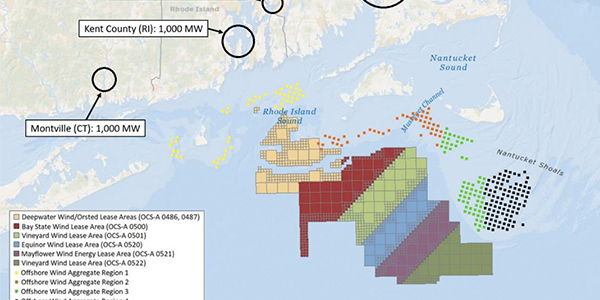New England’s carbon emissions could decrease by an average of 1.4 million to 1.5 million short tons per 1,000 MW of offshore wind capacity added in the region, with production costs falling by $128 million to $138 million, according to a new study by the New England States Committee on Electricity, the ISO-NE Planning Advisory Committee heard last week.
Impacts decrease as more megawatts are added, based on preliminary results from NESCOE’s 2019 Economic Study outlining scenarios with as much as 6,000 MW of OSW additions. It was presented by Patrick Boughan, an RTO senior engineer for system planning.
NESCOE, Anbaric Development Partners and RENEW Northeast submitted requests for additional studies at the PAC meeting in April. (See ISO-NE Planning Advisory Committee Briefs: April 25, 2019.)
Possible additions of 8,000 MW of offshore wind will be discussed at a subsequent PAC meeting. All such additions are in the southern portion of the New England system, Boughan said.
The analysis also shows annual average LMPs decreasing as offshore wind increases.
“Congestion is concentrated at the Surowiec-South interface [in Maine] and decreases as you add more offshore wind, decreasing by an average $16.5 million per 1,000 MW of offshore wind capacity,” Boughan said.
The assessment of offshore wind additions for the study do not take into consideration transmission upgrades associated with interconnection to the grid or Forward Capacity Market participation, he said.
“We’re using 2006 [National Renewable Energy Laboratory] offshore wind profiles due to their availability. However, we have new 2015 offshore wind profiles in development right now, and all these results today will be rerun with 2015 profiles,” Boughan said. “While we do expect those changes to affect the model, the trends we see in this presentation are expected to hold, and not vary significantly.”
Improving the Regional System Plan
ISO-NE Director of Market Development Carissa Sedlacek presented a summary of the 2019 Regional System Plan and asked stakeholders to help improve the process for making the plan.
Following a public forum in Boston in September, the RTO’s Board of Directors approved the 2019 RSP, which was posted on Oct. 31. (See Overheard at ISO-NE Regional System Plan Public Forum.)
“It takes nearly a year to develop the RSP, and we’re asking you what else we can do to make it better,” Sedlacek said.
The RTO last May held Grid Transformation Day as a special PAC meeting to present and discuss the technical challenges of a hybrid grid. The meeting and attendance exceeded expectations, she said. (See ‘Grid Transformation Day’ Highlights ISO-NE Challenges.)
“In January, we will send out a survey to PAC members and other stakeholders to seek input on how to improve the plan, focusing on finding new ways to keep the RSP forward-looking, and on how to streamline the development process,” Sedlacek said.




